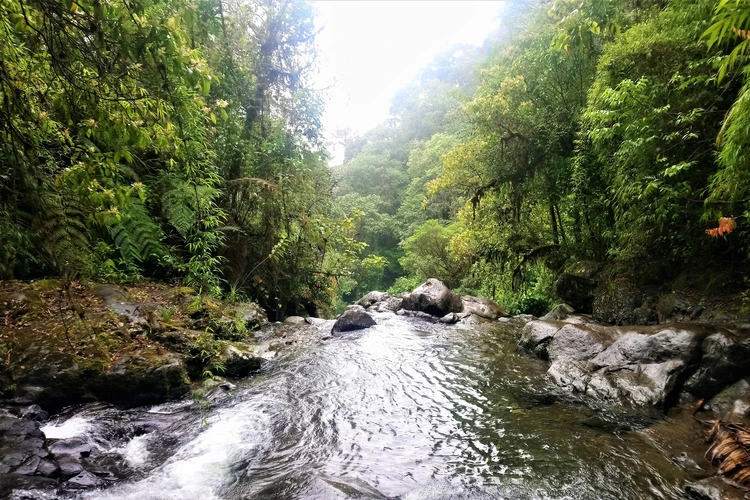

Geopolitical Hotspot
Tim Marshall on the relentless flow of migrants struggling through the treacherous jungle of the Darién Gap, desperate to reach the US
The Pan-American Highway stretches 30,000 kilometres from Ushuaia at the southern tip of Argentina up through Central and North America, ending in Prudhoe Bay, Alaska. It’s uninterrupted except for a 96-kilometre-wide stretch of mountains, jungle and swamps between Colombia and Panama – the Darién Gap.
Once considered impassable, the Darién Gap is the only land route connecting South and Central America. There are no official roads through, and yet each year, hundreds of thousands of people brave the dangerous terrain as they trek northwards, seeking a better life, usually in the US. President Trump’s threats to expel any who make it have seen numbers drop, but still they come.
Check out our related reads:
Smuggling gangs offer to guide people through the gap by advertising on social media sites showing pictures of camps set up in the jungle, complete with tents and wifi. Part of the region is known as the Darién National Park – but it’s no picnic. The cheapest routes offered are the longest and most dangerous and cost more than US$400 per person.
Passage through one of the wettest regions in the world takes about five days, but often longer. Many of the groups of migrants and asylum seekers arrive at Colombia’s southern entrance to the gap having left their homes because of poverty, discrimination, gang violence, political instability or natural disasters.
But in front of them they must face 96 kilometres of temperatures up to 35°C, hunger, disease, landslides, snakes, crocodiles, and the risk of being robbed or sexually assaulted by the drug cartels and paramilitary groups who’ve moved into people trafficking. Some die and are left where they fall. Carrying the body through miles of jungle isn’t an option.
Those who make it through are met by humanitarian organisations, which provide medical care and food and water. Most are then biometrically registered by the Panamanian authorities and continue their journeys north. It’s still another 5,600 kilometres to the US border via Costa Rica, Nicaragua, Honduras, Guatemala and Mexico.
Some run out of money and are stranded in places that have few resources to take care of them. Those who plod on are often joined by large numbers of people from the countries they pass though, forming caravans of people thousands strong.
Subscribe to Tim Marshall’s Substack here: https://substack.com/@itwitius
In 2023, a record 520,000 crossed the Darién Gap, about 20 per cent of them thought to be children. Most were from Venezuela, Ecuador and Haiti, others from various South American countries, but among them people from China, Vietnam, Afghanistan, Pakistan, DRC, Ethiopia and elsewhere.
Last year, the number dropped to 302,000, but that’s still far higher than the figures for 2022 (250,000) and 2021 (133,000).
The reduction is thought to be partially connected to the US’s decision last July to pay Panama to deport migrants back to their countries of origin. Only about 1,500 people have been flown out since then. However, this may have acted as a deterrent, along with other measures such as the US restricting visas for executives working for transportation companies that aid illegal migration.
This has led to increased attempts to bypass the Darién Gap and fly into countries north of Panama before taking to the road. Data from the UN’s International Organization for Migration suggests that since 2021, tens of thousands of migrants from Cuba and Africa have flown into Nicaragua on charter flights after it scrapped visa requirements.

Nicaragua, no friend of the US, requires most to leave within four days, but enjoys the revenues migrants bring in during their brief visits en route to the US border. Cooperation with its Central American neighbours on the issue is limited.
Mexico says the number of African migrants it has registered has tripled in three years, with many arriving on foot from countries to its south. To prevent its airports becoming a quick route to the US border, it has begun tightening visa regulations, and other countries may follow suit. Ecuador has already reinstated visa requirements for Chinese travellers.
All of the countries on the route up from the Darién Gap know that most of the people passing through only want to get to the US, but they also know that the trend of migrants being turned away will intensify with President Trump back in office.
In 2023, net immigration into the US was 3.3 million. As that falls, and deportations kick in, more people will be left in desperate conditions along the migration route. The Latin American states are unlikely to embrace the now abandoned US ethos: ‘Give me your tired, your poor, your huddled masses yearning to breathe free.’




